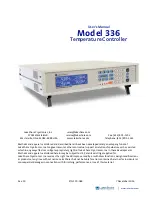
9
Cisco 5500 Series Wireless Controller Installation Guide
78-18998-01
Unpacking and Installing the Controller
The following additional items (not found in the accessory kit) are required to ground the chassis:
•
Grounding cable (6 AWG recommended), sized according to local and national installation
requirements; the required length depends on the proximity of the switch to proper grounding
facilities
•
Crimping tool large enough to accommodate girth of lug
•
Wire-stripping tool
Initial System Configuration Information
Obtain the following initial configuration parameters from your wireless LAN or network administrator:
•
A system (controller) name.
•
An administrative username and password. The default administrative username and password are
admin
and
admin
, respectively.
•
A service port interface IP address configuration protocol (none or DHCP).
•
A management interface (DS port or network interface port) IP address.
Note
The service port interface and management interface must be on different subnets.
•
A management interface netmask address.
•
A management interface default router IP address.
•
A VLAN identifier if the management interface is assigned to a VLAN, or 0 for an untagged VLAN.
•
Distribution system physical port number—1 through 8 for front panel Gigabit Ethernet ports.
•
IP address of the default DHCP server that will supply IP addresses to clients.
•
The Control And Provisioning of Wireless Access Points Protocol (CAPWAP) transport mode
(Layer 3).
•
A virtual gateway IP address (a fictitious, unassigned IP address, such as 1.1.1.1, used by all Cisco
wireless LAN controller Layer 3 security and mobility managers).
•
A Cisco wireless LAN controller mobility group name, if required.
•
An 802.11 network name (SSID) for WLAN 1. This is the default SSID that the access points use
when they join with the controller.
•
Whether or not to allow static IP addresses from clients.
–
Yes is more convenient, but has lower security (session can be hijacked).
–
No is less convenient, but has higher security and works well for Windows XP devices.
•
RADIUS server IP address, communications port, and secret (if you are configuring a RADIUS
server).
•
The country code for this installation. Refer to the
Cisco Wireless LAN Controller Configuration
Guide
for country code information. This guide is available at cisco.com.
•
Status of the 802.11a, 802.11b, 802.11g, and 802.11n networks (enabled or disabled).
•
Status of radio resource management (RRM) (enabled or disabled).










































